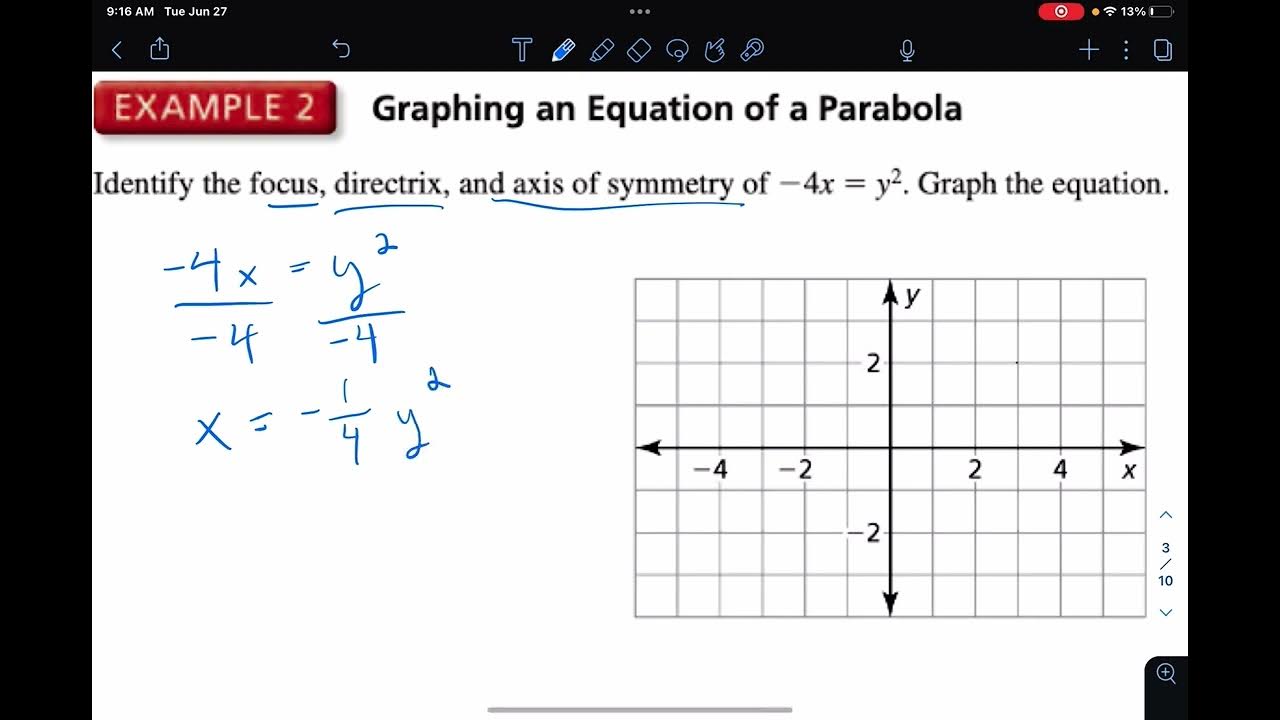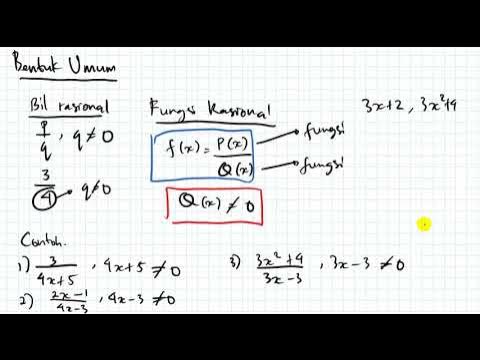Review on Parabola
Summary
TLDRThis educational video tutorial covers the fundamentals of parabolas, focusing on their standard forms for both vertical and horizontal orientations. It explains the components of a parabola, including vertex, focus, axis of symmetry, directrix, and latus rectum. The presenter demonstrates how to derive these components using formulas and the definition method, applying them to a sample problem. Additionally, the video addresses converting a parabola from general to standard form and highlights real-world applications, such as satellite dishes, emphasizing the importance of understanding parabolas in engineering and technology.
Takeaways
- 📐 The video discusses the standard form of parabolas, distinguishing between vertical and horizontal orientations.
- 🔄 The standard form for a vertical parabola is \((x-h) = 4p(y-k)\), while for a horizontal parabola, it's \((y-k) = 4p(x-h)\).
- 🔄 The video emphasizes that the orientation of the parabola (upward/downward for vertical, leftward/rightward for horizontal) is determined by the term that is squared.
- 🔍 The components of a parabola include the vertex, focus, axis of symmetry, directrix, and latus rectum, which are explained in the video.
- 📉 The video demonstrates how to find the vertex and focus of a parabola using the formulas \(h = -\frac{1}{4a}\) and \(k = -\frac{1}{4a}\) respectively, where \(a\) is the coefficient of the squared term.
- 📏 The directrix is found using the formula \(y = k - p\) for vertical parabolas, and the axis of symmetry is \(x = h\).
- 🔢 The video provides a method to convert a parabola from general to standard form by completing the square and rearranging terms.
- 🛰️ An application of parabolas discussed is their use in satellite dishes, which are shaped like parabolas to capture and focus signals towards a central point, known as the focus.
- 📡 The video explains that the focal length, or the distance between the vertex and the focus, can be found using the absolute value of \(p\) from the standard form equation.
- 🔧 A practical problem-solving approach is demonstrated by applying the knowledge of parabolas to determine the optimal placement of a receiver in a satellite dish setup.
Q & A
What are the two types of parabolas discussed in the video?
-The two types of parabolas discussed are vertical and horizontal parabolas.
What is the standard form of a vertical parabola?
-The standard form of a vertical parabola is \( (x-h)^2 = 4p(y-k) \).
How can you identify a horizontal parabola from its equation?
-A horizontal parabola can be identified if the equation has \( (y-k)^2 = 4p(x-h) \), where the squared term is \( y \).
What is the significance of the term 'p' in the parabola equation?
-The term 'p' in the parabola equation represents the distance from the vertex to the focus or the directrix.
What are the components of a parabola mentioned in the video?
-The components of a parabola mentioned are the vertex, focus, axis of symmetry, directrix, and latus rectum.
How can you find the vertex of a parabola given its equation?
-The vertex of a parabola can be found using the formula \( (h, k) \), where \( h \) and \( k \) are the values that make the equation equal to zero after being substituted back into the equation.
What is the formula to find the focus of a vertical parabola?
-The formula to find the focus of a vertical parabola is \( (h, k+p) \), where \( h \) and \( k \) are the coordinates of the vertex.
How is the directrix of a parabola defined and how can you find it?
-The directrix of a parabola is a line that is perpendicular to the axis of symmetry and never touches the parabola. For a vertical parabola, it can be found using the formula \( y = k - p \).
What is the axis of symmetry for a parabola and how can you determine it?
-The axis of symmetry for a parabola is a vertical or horizontal line that passes through the vertex and divides the parabola into two mirror-image halves. It can be determined using the formula \( x = h \) for vertical parabolas.
How can you sketch the graph of a parabola given its equation?
-To sketch the graph of a parabola, first identify the vertex and the direction it opens (upward or downward for vertical, leftward or rightward for horizontal). Then, use the value of 'p' to determine the width and narrowness of the parabola's curve.
What is the application of parabolas mentioned in the video?
-The application of parabolas mentioned is in the design of satellite dishes, which use the parabolic shape to focus incoming signals to a central point, the focus.
How can you convert a parabola from general form to standard form?
-To convert a parabola from general form to standard form, you need to isolate the squared term on one side of the equation, complete the square for the other terms, and simplify.
Outlines

هذا القسم متوفر فقط للمشتركين. يرجى الترقية للوصول إلى هذه الميزة.
قم بالترقية الآنMindmap

هذا القسم متوفر فقط للمشتركين. يرجى الترقية للوصول إلى هذه الميزة.
قم بالترقية الآنKeywords

هذا القسم متوفر فقط للمشتركين. يرجى الترقية للوصول إلى هذه الميزة.
قم بالترقية الآنHighlights

هذا القسم متوفر فقط للمشتركين. يرجى الترقية للوصول إلى هذه الميزة.
قم بالترقية الآنTranscripts

هذا القسم متوفر فقط للمشتركين. يرجى الترقية للوصول إلى هذه الميزة.
قم بالترقية الآنتصفح المزيد من مقاطع الفيديو ذات الصلة

Conic Sections - Circles, Semicircles, Ellipses, Hyperbolas, and Parabolas

A2 Focus and Directrix

Draw Parabola Grade 11 | Part 1 | Grade 11 Functions

Fungsi Rasional kelas XI Matematika Tingkat Lanjut (Kurikulum Merdeka)

Projectile Motion: 3 methods to answer ALL questions!

3D printing bolt and thread in horizontal or vertical position - strength test
5.0 / 5 (0 votes)
